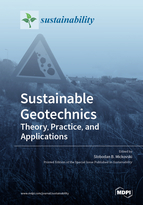Sustainable Geotechnics—Theory, Practice, and Applications
A special issue of Sustainability (ISSN 2071-1050).
Deadline for manuscript submissions: closed (31 January 2021) | Viewed by 25336
Special Issue Editor
Interests: soil; sustainability; climate change; strength; resilience
Special Issues, Collections and Topics in MDPI journals
Special Issue Information
Dear Colleagues,
Today, modern geotechnical engineers, who in the past would have considered the phenomena occurring in the (primarily soil) environment, are faced with developments in environmental sciences that are becoming more and more detailed and sophisticated, with the natural phenomena and processes surrounding the civil engineering infrastructure being modeled, designed, monitored, and assessed in a more holistic way. This Special Issue aims to bring together the state of the art in geotechnics with a focus on sustainable design, construction, and monitoring of the performance of geotechnical assets from ground investigations, through foundation and drainage design to soil stabilization and reinforcement. Submissions from engineers and scientists working in the fields of green infrastructure, nature-based solutions, sustainable drainage, eco-engineering, hydro-geology, landscape planning, plant science, environmental biology or bio-chemistry, earth sciences, GIS, and remote sensing are particularly encouraged to submit articles with significant geotechnical components or applications. Case studies showcasing the application of the sustainable development principles (e.g., reuse, recycle, reduce; stakeholder engagement; public health; UN Global Sustainability Goals) in geotechnics are particularly welcome.
Prof. Slobodan B. Mickovski
Guest Editor
Manuscript Submission Information
Manuscripts should be submitted online at www.mdpi.com by registering and logging in to this website. Once you are registered, click here to go to the submission form. Manuscripts can be submitted until the deadline. All submissions that pass pre-check are peer-reviewed. Accepted papers will be published continuously in the journal (as soon as accepted) and will be listed together on the special issue website. Research articles, review articles as well as short communications are invited. For planned papers, a title and short abstract (about 100 words) can be sent to the Editorial Office for announcement on this website.
Submitted manuscripts should not have been published previously, nor be under consideration for publication elsewhere (except conference proceedings papers). All manuscripts are thoroughly refereed through a single-blind peer-review process. A guide for authors and other relevant information for submission of manuscripts is available on the Instructions for Authors page. Sustainability is an international peer-reviewed open access semimonthly journal published by MDPI.
Please visit the Instructions for Authors page before submitting a manuscript. The Article Processing Charge (APC) for publication in this open access journal is 2400 CHF (Swiss Francs). Submitted papers should be well formatted and use good English. Authors may use MDPI's English editing service prior to publication or during author revisions.
Keywords
- built environment
- construction
- eco-engineering
- geotechnical design
- green infrastructure
- ground bio-engineering
- monitoring
- nature-based solution
- stakeholder engagement
- sustainability






